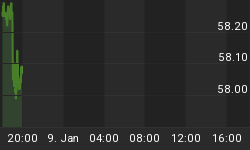It's axiomatic that when it comes to economic forecasting, at a top the majority will extrapolate the good times indefinitely into the future, and at a bottom they will extrapolate the bad times.
But this forecasting "technique" will prove to be wrong, time and time again.
Fortunately there is no need to go with your gut on this, or listen to the opinions of economic doom-and-gloomers -- currently enjoying their moment in the spotlight -- or even wide-eyed optimists.
There is a simple, yet highly effective, objective leading economic indicator that merely has to be checked once a week to know what is going to happen in our shared economic future.
I am referring to the Weekly Leading Index (WLI) from the Economic Cycle Research Institute (ECRI). The ECRI has synthesized an array of proven leading economic indicators -- housing data, interest rates, commodity prices, etc -- into one data point, which has been battle-tested over generations.
The key point here is these are leading indicators. Almost everything we hear about in the financial news is either a coincident, or a lagging indicator. So it's meaningless for the future, but coming out of a huge economic low this spot news-flow will sure make you feel bad.
I'm sure it will surprise a few people to learn that the growth rate on the Weekly Leading Index from the ECRI has just hit an all-time high, at +22.9%.
This is now the strongest economic recovery in the history of this data.

On this chart from the ECRI, I've circled every instance where the growth rate shot up like this during a recovery. In every instance the coincident indicator (blue line) -- which measures the actual economy in real-time -- soon followed a similar growth path up.
So we can expect a major, sustained move up in economic growth, lasting at least a year from the launch point, and more likely closer to 2 years. I think this helps to explain the sustained underlying bid in equity markets, even during the traditionally weak month of September.
So how come so few people are picking up on this? It's due to the "giant error of pessimism" that the ECRI refers to as a popular mind-set during the early stages of a recovery. Very few are looking at these tried-and-true predictive indicators, and instead are extrapolating the recent negative events into the future. Much like most people extrapolate the good times into the future at the top.
Obviously equity markets -- the most famous leading economic indicator -- are sensing this robust recovery, and are re-rating prices quickly back up. I also think there is a healthy dose of currency pressure in this recovery rally, as the dollar index breaks back down towards the lows, which creates upward energy in tangible assets, including gold -- especially gold -- and equities.
Although most of the commentary about the bullish case for gold is based on some form of looming economic catastrophe, I think recent evidence proves this to be exactly opposite of what is actually transpiring.
I have long maintained that gold will only launch into the stratosphere during a major economic recovery, as loose monetary conditions combine with a resurgent private sector. And this is precisely what is happening now.

Let me say this one more time, just to emphasize the point:
It is economic strength -- not weakness -- that will push gold well above $1,000, and likely over $2,000 by early 2011.
And fortunately, we are seeing evidence right now from the leading economic indicators that we're now experiencing the most robust economic recovery in history.
So while there may be further economic doom-and-gloom in our more distant future, if you look at the situation objectively, right now, it's not going to happen over the next 18 months or so.
In my daily Fractal Gold Report, I have outlined a very specific road-map for gold out into 2012 that is proving to be highly accurate. If you sign up for our free trial offer, you will have immediate access to two Special Reports which give further details on gold's path out to 2012, including much more on the highly-reliable parabolic growth pattern characteristic of "market bubbles", where capital becomes temporarily over-concentrated in one sector.
Gold is right now on the verge of launching into the juiciest part of this growth curve, and it will be critical over the next 3 years to know exactly where gold is on this pattern.















